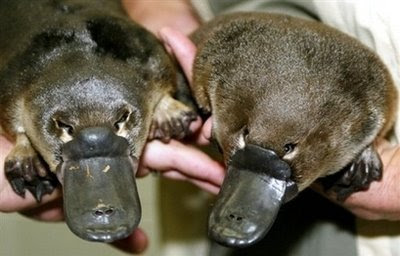The world's first platypus twin puggles
born in captivity are shown at Taronga Zoo in Sydney in 2003. The task
of laying bare the platypus genome of 2.2 billion base pairs spread
across 18,500 genes has taken several years, but will do far more than
satisfy the curiosity of just biologists, say the researchers.
Arguably the oddest beast in Nature's menagerie, the platypus looks as if were assembled from spare parts left over after the animal kingdom was otherwise complete.
 Now
scientists know why. According to a study released Wednesday, the
egg-laying critter is a genetic potpourri -- part bird, part reptile and
part lactating mammal.
Now
scientists know why. According to a study released Wednesday, the
egg-laying critter is a genetic potpourri -- part bird, part reptile and
part lactating mammal.
The task of laying bare the platypus genome of 2.2 billion base pairs spread across 18,500 genes has taken several years, but will do far more than satisfy the curiosity of just biologists, say the researchers.
"The platypus genome is extremely important, because it is the missing link in our understanding of how we and other mammals first evolved," explained Oxford University's Chris Ponting, one of the study's architects.
"This is our ticket back in time to when all mammals laid eggs while suckling their young on milk."
Native to eastern Australia and Tasmania, the semi-aquatic platypus is thought to have split off from a common ancestor shared with humans approximately 170 million years ago.
The creature is so strange that when the first stuffed specimens arrived in Europe at the end of the 18th century, biologists believed they were looking at a taxidermist's hoax, a composite stitched together from the body of a beaver and the snout of a giant duck.
But the peculiar mix of body features are clearly reflected in the animal's DNA, the study found.
The platypus is classified as a mammal because it produces milk and is covered in coat of thick fur, once prized by hunters.
Lacking teats, the female nurses pups through the skin covering its abdomen.
But there are reptile-like attributes too: females lay eggs, and males can stab aggressors with a snake-like venom that flows from a spur tucked under its hind feet.
The bird-like qualities implied by its Latin name, Ornithorhynchus anatinus, include webbed feet, a flat bill similar to a duck's, and the gene sequences that determine sex. Whereas humans have two sex chromosomes, platypuses have 10, the study showed.
"It is much more of a melange than anyone expected," commented Ewan Birney, who led the genome analysis at the European Bioinformatics Institute in Cambridge.
The animal also possesses a feature unique to monotremes -- an order including a handful of egg-laying mammals -- called electroreception.
With their eyes, ears and nostrils closed, platypuses rely on sensitive electrosensory receptors tucked inside their bills to track prey underwater, detecting electrical fields generated by muscular contraction.
"By comparing the platypus genome to other mammalian genomes, we'll be able to study genes that have been conserved throughout evolution," said senior author Richard Wilson, a researcher at Washington University.
In captivity, platypuses have lived up to 17 years of age.
In the wild, they feed on worms, insect larvae, shrimps and crayfish, eating up to 20 percent of their body weight every day.
Males grow to a length of 50 centimetres (20 inches) and weigh about two kilos (4.5 pounds), with females about 20 percent shorter and lighter.
The genome sequenced for the study belongs to a female specimen from New South Wales nicknamed Glennie
Arguably the oddest beast in Nature's menagerie, the platypus looks as if were assembled from spare parts left over after the animal kingdom was otherwise complete.
 Now
scientists know why. According to a study released Wednesday, the
egg-laying critter is a genetic potpourri -- part bird, part reptile and
part lactating mammal.
Now
scientists know why. According to a study released Wednesday, the
egg-laying critter is a genetic potpourri -- part bird, part reptile and
part lactating mammal.The task of laying bare the platypus genome of 2.2 billion base pairs spread across 18,500 genes has taken several years, but will do far more than satisfy the curiosity of just biologists, say the researchers.
"The platypus genome is extremely important, because it is the missing link in our understanding of how we and other mammals first evolved," explained Oxford University's Chris Ponting, one of the study's architects.
"This is our ticket back in time to when all mammals laid eggs while suckling their young on milk."
Native to eastern Australia and Tasmania, the semi-aquatic platypus is thought to have split off from a common ancestor shared with humans approximately 170 million years ago.
The creature is so strange that when the first stuffed specimens arrived in Europe at the end of the 18th century, biologists believed they were looking at a taxidermist's hoax, a composite stitched together from the body of a beaver and the snout of a giant duck.
But the peculiar mix of body features are clearly reflected in the animal's DNA, the study found.
The platypus is classified as a mammal because it produces milk and is covered in coat of thick fur, once prized by hunters.
Lacking teats, the female nurses pups through the skin covering its abdomen.
But there are reptile-like attributes too: females lay eggs, and males can stab aggressors with a snake-like venom that flows from a spur tucked under its hind feet.
The bird-like qualities implied by its Latin name, Ornithorhynchus anatinus, include webbed feet, a flat bill similar to a duck's, and the gene sequences that determine sex. Whereas humans have two sex chromosomes, platypuses have 10, the study showed.
"It is much more of a melange than anyone expected," commented Ewan Birney, who led the genome analysis at the European Bioinformatics Institute in Cambridge.
The animal also possesses a feature unique to monotremes -- an order including a handful of egg-laying mammals -- called electroreception.
With their eyes, ears and nostrils closed, platypuses rely on sensitive electrosensory receptors tucked inside their bills to track prey underwater, detecting electrical fields generated by muscular contraction.
"By comparing the platypus genome to other mammalian genomes, we'll be able to study genes that have been conserved throughout evolution," said senior author Richard Wilson, a researcher at Washington University.
In captivity, platypuses have lived up to 17 years of age.
In the wild, they feed on worms, insect larvae, shrimps and crayfish, eating up to 20 percent of their body weight every day.
Males grow to a length of 50 centimetres (20 inches) and weigh about two kilos (4.5 pounds), with females about 20 percent shorter and lighter.
The genome sequenced for the study belongs to a female specimen from New South Wales nicknamed Glennie








 5:14 PM
5:14 PM
 infosite
infosite

 Posted in:
Posted in: 











